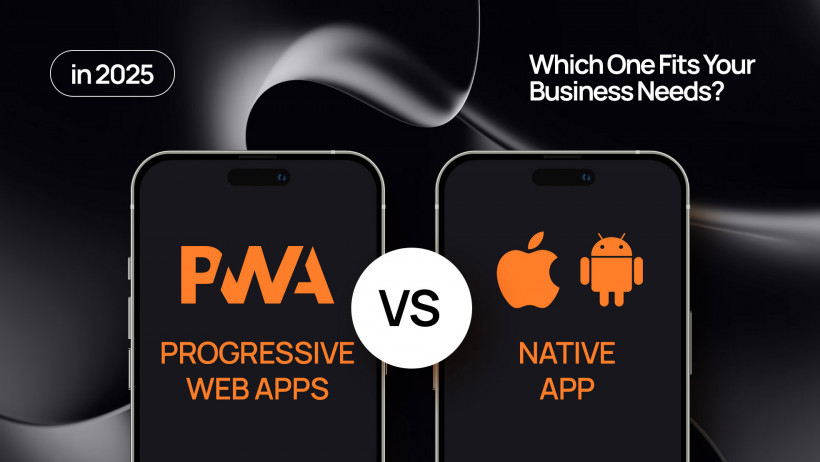Choosing between a PWA vs native app? You’re not alone.
In 2025, businesses of all sizes face this decision when planning their digital strategy. The competition for user attention is fierce, and mobile-first experiences are no longer optional, they’re expected.
Over the past few years, progressive web apps vs native apps have become a central debate. PWAs have matured and narrowed the gap with native applications, while native solutions continue to push boundaries in terms of performance and integration. The stakes are higher: the choice you make directly impacts customer satisfaction, visibility, and costs.
So, which is better: PWA or native app for your business? Let’s break it down.
What Is a Progressive Web App (PWA)?
How It Works
A Progressive Web App (PWA) is essentially a website that behaves like a mobile application. Built with standard web technologies such as HTML, CSS, and JavaScript, it runs directly in the browser but can be installed on a device’s home screen for an app-like experience.
Thanks to service workers, PWAs can work offline, send push notifications, and cache resources to ensure faster load times.
Advantages for Modern Web Users

- Installability: users can add the app to their device without visiting an app store.
- Cross-platform compatibility: one codebase works on both iOS and Android.
- Offline access: service workers allow limited functionality even without an internet connection.
- SEO benefits of PWAs: unlike native apps, PWAs are indexed by search engines, improving discoverability.
- Lower entry barrier: no need for app store approvals or downloads.
What Is a Native App?
Key Characteristics
A native mobile app is developed specifically for a platform, usually iOS (Swift/Objective-C) or Android (Kotlin/Java). It must be downloaded and installed from the App Store or Google Play.
Device Integration and Performance
Because native apps are built for a particular operating system, they have deep integration with device features such as:
- Camera and microphone
- GPS and sensors
- Bluetooth and NFC
- Background processes
This translates into high performance, richer user interactions, and smoother animations, which still make native apps the gold standard for resource-intensive solutions like gaming or fintech applications.
PWA vs Native: Side-by-Side Comparison
Before making a final decision, it helps to see the differences in a clear, side-by-side format. Both options bring unique strengths, but the right choice often depends on your priorities like speed, reach, cost, or performance. Let’s compare the essentials:
| Feature | Mobile PWA vs Native |
|---|---|
| Performance | Native apps lead with optimized speed and device resource usage. PWAs are catching up but can’t yet match high-end gaming or AR/VR. |
| User experience | Native delivers the most polished experience; PWAs are excellent for standard interactions. |
| Accessibility | PWAs run in browsers and can be shared via a link. Native apps require downloads from the App Store or Google Play. |
| Offline capability | PWAs support offline access for cached content; native apps offer more robust offline functionality. |
| Cost & development speed | PWAs are faster and cheaper to build since one version works everywhere. Native apps require separate builds for iOS and Android. |
| Updates & maintenance | PWAs update instantly via the web; native apps require store submissions and user downloads. |
| App Store presence | Native apps have visibility and credibility in official stores. PWAs are outside these ecosystems unless wrapped as hybrids. |
As you can see, there is no absolute winner in the progressive web apps vs native apps debate. PWAs excel in accessibility, speed of deployment, and lower costs, making them a great fit for businesses looking to test ideas quickly or expand their reach. Native apps, meanwhile, dominate in performance, deep device integration, and user trust through App Store visibility. The key is to match the strengths of each option with the specific needs of your business and audience.
When to Choose PWA for Your Business

PWAs shine in scenarios where speed, accessibility, and cost-efficiency matter most. They allow companies to quickly reach a wide audience without the heavy investment that comes with native development. Here are the most common situations where a PWA is the smarter choice:
- Web-first product strategy: If your business already has a strong online presence, a PWA extends it seamlessly to mobile. For example, an online retailer with an established website can offer customers an app-like shopping experience without building separate iOS and Android apps.
- Fast launch needs: Ideal for startups and SMEs that want to test an idea quickly. A PWA can be built and deployed within weeks, helping you validate your concept before committing to more expensive native development.
- SEO visibility: Because PWAs are indexed by search engines, they can attract organic traffic and improve online reach. This is particularly valuable for content-driven platforms, blogs, or online stores that rely on search visibility to grow their user base.
- Lightweight solutions: Great for eCommerce catalogs, booking apps, or service portals where offline access and quick installs matter. Customers can browse products, check bookings, or review services even without a stable connection — something that’s critical in markets with inconsistent internet coverage.
- Lower maintenance and updates: Since PWAs update automatically through the web, you avoid the delays of app store approvals. This is perfect for businesses that need to roll out frequent content or feature updates, such as news platforms or education providers.
- Cross-platform reach: With one codebase, PWAs work across devices and operating systems, reducing development costs while ensuring consistent experiences. This is especially useful for businesses targeting a global audience where users may have a mix of iOS and Android devices.
In short, if your goal is to reach more users faster, at a lower cost, and without sacrificing too much functionality, a PWA is often the right call.
When Native Is the Right Choice
There are times when only a native app makes sense:
- High-performance needs: Gaming, augmented reality, or fintech apps requiring real-time calculations.
- Rich user interaction: Apps that rely on gestures, animations, or advanced hardware integration.
- Complex integrations or security needs: Banking, healthcare, and enterprise solutions often require the deeper security controls native apps provide.
- App Store credibility: For some businesses, being listed in the App Store is a trust factor that influences user adoption.
Hybrid Alternatives: Is There a Middle Ground?
Yes. For businesses that want the best of both worlds, hybrid solutions are worth considering:
- PWA shell in App Store: Some companies package their PWA with native wrappers (like Cordova or Capacitor) to distribute through app stores.
- PWA with native wrappers: These allow push notifications in PWA on iOS, extended offline access, and access to device APIs.
While not always as powerful as full native apps, these hybrids give flexibility without doubling development efforts.
How WEZOM Helps You Choose and Build the Right Type of App
At WEZOM, we know that the choice between PWA vs native app isn’t about trends, it’s about aligning technology with your long-term business goals. The right decision can save you time, money, and headaches while giving your users the seamless digital experience they expect.
Business-Driven Tech Decision Making
We start by diving deep into your product vision, audience, and market needs. Instead of offering one-size-fits-all solutions, we recommend the most effective approach whether it’s a PWA for business that helps you scale quickly or a full-featured native build designed for performance and reliability.
Expertise in PWA and Native Stacks
Our development team is fluent in the tech stack differences that matter. From modern JavaScript frameworks (React, Angular, Vue) for PWAs to platform-native technologies like Swift, Kotlin, and Flutter, we know how to build apps that are fast, secure, and future-ready. This flexibility allows us to adapt the solution to your unique challenges rather than forcing you into a single technology path.
End-to-End Development Support
Building the right app doesn’t stop at coding, it’s about creating a product that delivers business results. That’s why our support covers the entire journey:
- Strategy workshops to align your digital product with business objectives.
- UI/UX design tailored to your audience, ensuring smooth and engaging user experiences.
- Scalable architecture planning so your app grows as your business grows.
- Continuous updates and maintenance to keep your solution secure, relevant, and optimized for new market demands.
With WEZOM, you’re not just choosing between a PWA and a native app, you’re choosing a partner that helps you make the smartest decision for your business growth.

Conclusion
There’s no universal answer to which is better PWA or native app. In 2025, the choice depends less on technology and more on what your users expect and how your business operates.
- If you need fast deployment, cross-platform reach, and SEO visibility, PWAs are a strong contender.
- If performance, advanced interactions, or App Store presence are critical, native apps remain unbeatable.
- And if you want both, hybrid approaches can bridge the gap.
The bottom line: there is no “best” choice, only the one that best fits your business needs.
Ready to explore your options? Let’s talk about how WEZOM can help you build the mobile solution your customers will love.

